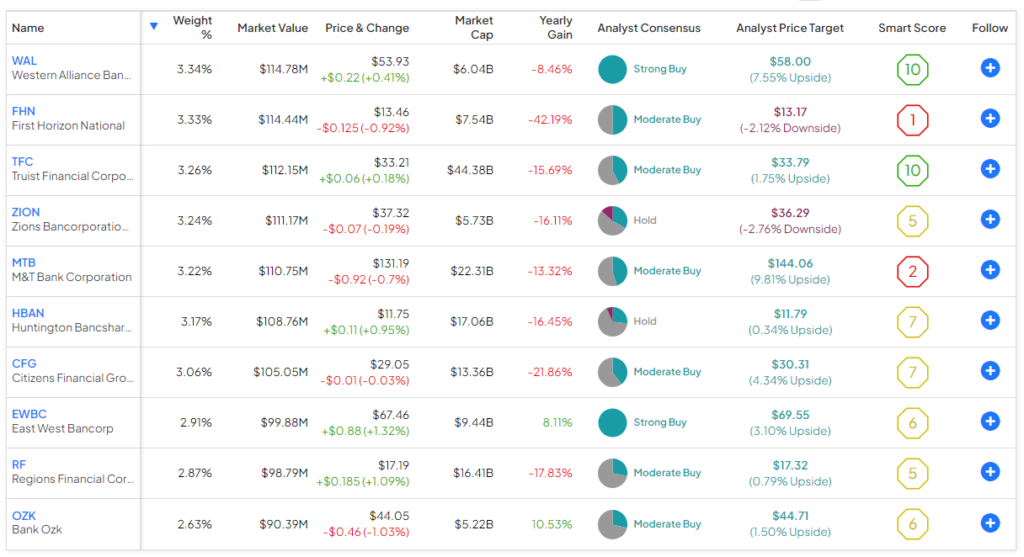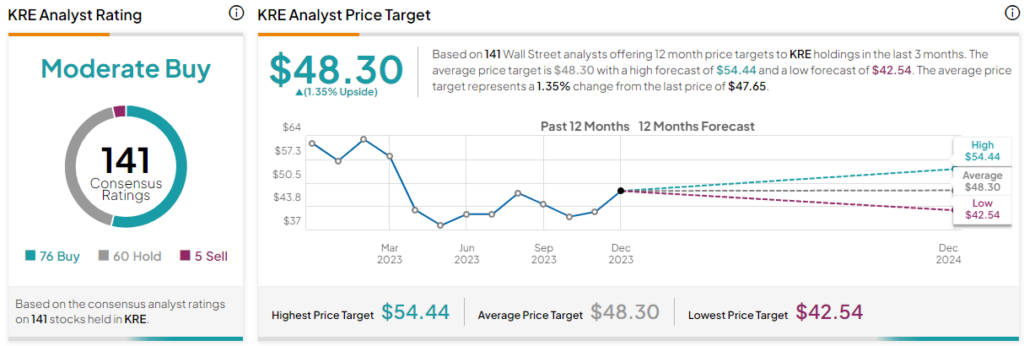Legendary investor Bill Gross, often referred to as the “Bond King,” recently reported that he is buying the dip in regional bank stocks. The SPDR S&P Regional Banking ETF (NYSEARCA:KRE) is a good way for investors to gain exposure to a wide range of these stocks in one convenient vehicle. I’m bullish on KRE, given its inexpensive valuation and large dividend yields of its holdings, plus Gross’ optimism about the sector.
Discover the Best Stocks and Maximize Your Portfolio:
- See what stocks are receiving strong buy ratings from top-rated analysts.
- Filter, analyze, and streamline your search for investment opportunities with TipRanks’ Stock Screener.
What Does the Bond King See in Regional Banks?
Gross created the first investable market for fixed-income securities, pioneered active bond trading, founded investment giant PIMCO, which he helped to build into the largest active fixed-income manager in the world, and ran one of the world’s largest mutual funds, the PIMCO Funds Total Return Fund (NASDAQ:PTTRX). In this role, he handled more bond money than anyone in the world.
Morningstar (NASDAQ:MORN) named Gross the fixed income “Fund Manager of the Decade” in 2010, writing, “No one made more money for people than Bill Gross.”
According to PIMCO’s website, an investor who put $10,000 into the institutional share class of the fund in May 1987, when the fund started, would have nearly $80,000 by the end of September 2014, around the time Gross left the firm.
Given Gross’ acumen as an investor and the fact that he more typically traffics in bonds than in equities, when he does comment on equities, astute investors pay attention.
Regional bank stocks sold off earlier this year after the implosion of Silicon Valley Bank and several smaller banks, but Gross believes much of this danger has passed and that the “falling knife has hit bottom.” He has previously noted that the shares of some of these stocks offer “extraordinary long-term value.”
Gross recently said that he is buying shares of four prominent regional bank stocks — Truist Financial (NYSE:TFC), Citizens Financial Group (NYSE:CFG), KeyCorp (NYSE:KEY), and First Horizon (NYSE:FHN).
What do these regional bank stocks have in common? They combine below-market valuations with appetizing dividend yields.
For example, Citizens Financial shares trade at just under two-thirds of their book value (essentially what the company would be worth if it were to be liquidated today), offering investors a decent margin of safety.
At the same time, shares of Citizens Financial yield nearly 6%, easily surpassing the yields offered by treasury bonds, the S&P 500 (SPX), and even the rate of inflation. This is a tasty combination for value investors, and it’s easy to see why Gross likes this sector of the market.
Similarly, Truist, which is the eighth-largest bank in the U.S., trades at about four-fifths of book value and yields 6.25%.
Gross’ other picks, KeyCorp and First Horizon, don’t offer the same discount to book value, but they offer attractive dividend yields of 6.2% and 4.45%, respectively.
This combination of attractive valuation and above-average yield is what many regional bank stocks have to offer investors today. The KRE ETF allows investors to seize the opportunity represented here and gain exposure to a broad group of these regional bank picks while spreading out risk. By investing in a diversified group of regional bank stocks, you can protect yourself from the danger of one of these stocks running into trouble.
What is the KRE ETF’s Strategy?
According to the fund’s website, KRE “seeks to provide investment results that, before fees and expenses, correspond generally to the total return performance of the S&P Regional Banks Select Industry Index.” Inclusion in this index is based on Global Industry Classification Standard (GICS) classification as well as liquidity and market cap requirements.
KRE is a $3.0 billion fund that has been around since 2006.
A Balanced Portfolio of Regional Banks
Investing in KRE allows investors to gain exposure to a wide variety of characteristics that Gross finds attractive in regional banks. The ETF holds 141 stocks, and its top 10 holdings make up a reasonable 31% of the fund.
Below, you’ll find an overview of KRE’s top 10 holdings using TipRanks’ holdings tool.

As you can see, many of Gross’ picks are well-represented right here within the KRE ETF’s top 10 holdings, including First Horizon, which is the fund’s second-largest holding; Truist, which comes in third; and Citizens Financial, which is the seventh-largest holding.
Overall, these holdings are collectively very cheap. They trade for just a hair above book value and just 8.7 times earnings, which represents a substantial discount to the S&P 500 (which has an average price-to-earnings multiple of 20.4).
What Does KRE’s Dividend Yield Look Like?
KRE’s dividend yield of 3.2% isn’t as attractive as those of some of its top holdings, but it is still a decent payout overall and roughly double the yield of the S&P 500. KRE has paid a dividend for 13 years in a row.
Reasonable Expense Ratio
KRE features a reasonable enough expense ratio of 0.35%. This means that an investor putting $10,000 into the fund today would pay $35 in fees over the course of one year. Assuming the ETF returns 5% per year going forward and that the expense ratio stays at 0.35%, this same investor will pay $197 over the course of five years and $443 over the course of 10 years.
Is KRE Stock a Buy, According to Analysts?
Turning to Wall Street, KRE earns a Moderate Buy consensus rating based on 76 Buys, 60 Holds, and five Sell ratings assigned in the past three months. The average KRE stock price target of $48.50 implies 1.35% upside potential.

You Can Invest Like Bill Gross
Today, regional banks feature a tempting combination of discounted valuations and above-average dividend yields. The KRE ETF is a good way to invest in a broad group of these inexpensive stocks, mitigating single-stock risk.
Gross is one of the most famed investors of all time for a reason, and he has an eye for value. He is a discerning investor, but he sees value in regional banks. For these reasons, I’m bullish on the KRE ETF as a long-term value and dividend investment.









